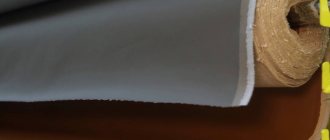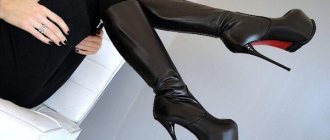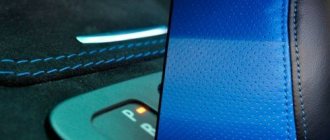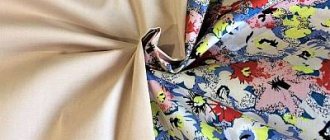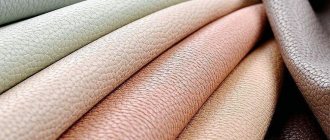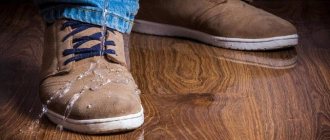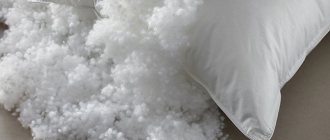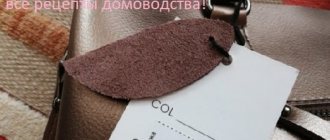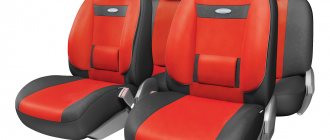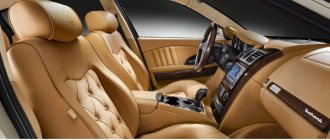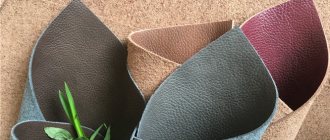Eco-leather or artificial leather, which is better?
Leatherette began to be produced in the middle of the 20th century. Its basis is fabric-reinforced PVC sheets. During the production process, plasticizers and stabilizers are used, due to which the material has an unpleasant chemical odor and releases toxic substances when heated.
Eco-leather began to be produced at the beginning of the 21st century. Its base is cotton or polyester, sometimes with the addition of pressed leather shavings. On which polypropylene is applied. This is an environmentally friendly substance compared to polyvinyl chloride. To obtain a material that looks like leather, you do not need to use plasticizers and stabilizers.
The production method and composition are the first differences between eco-leather and leatherette. But this is not the only difference between these two materials. By changing the film coating, eco-leather has acquired properties that bring it closer to natural leather. The resulting fabric became porous. The pore size is such that moisture is removed from the body without compromising the waterproofness of the material. Due to the heterogeneous structure, eco-leather allows air to pass through.
The woven base of eco-leather makes it elastic. Clothes made from it fit better, and shoes are more practical to wear.
The difference between the two materials is their structure. Eco-leather is essentially a fabric base on which a polypropylene film is applied. That is, the material is closer to ordinary fabrics. In percentage terms, it consists of only 25% polymer, and 75% cotton or polyester. Faux leather consists of sheets of polyvinyl chloride held together with a woven backing. The material consists of 70% polymers and plasticizers.
The production of artificial leather without PVC is environmentally friendly. It does not harm the environment as no toxic substances are used. The material is harmless to humans.
The answer to the question of which is better eco-leather or artificial leather is the first option. Since the material is environmentally friendly, it has the best consumer qualities.
The advantage of genuine leather over substitutes
The leather is not only stylish and beautiful, but also of high quality. Therefore, products made from this material are the standard.
Professionals explain why natural leather is better than artificial leather:
- Hypoallergenic. The fabric is made from environmentally friendly materials.
- Wear resistance. With proper care, leather products will last 10 years or more. Over time, they will look more vintage and stylish due to natural bruising.
- High strength, wear resistance.
- Resistant to temperature changes and wind.
Advantages and disadvantages of eco-leather
Artificial leather without PVC has undeniable advantages over its predecessor and can even compete with natural leather. Advantages of high-tech material:
- strength - it is difficult to tear, it is resistant to friction, unlike leatherette;
- high hygienic indicators - the fabric is breathable, it allows air to pass through to the body and removes moisture from it. Due to this, a sauna effect is not created;
- resistance to low temperatures - the material does not crack in the cold, does not harden;
- hypoallergenic - does not cause irritation for people with sensitive skin. This property distinguishes eco-leather from natural and artificial leather;
- UV resistance - the fabric does not deteriorate under the influence of sunlight and does not fade;
- elasticity and elasticity - the fabrics stretch, but do not deform, clothes do not stretch on the knees or butt;
- water resistance - the fabric does not allow water to pass through;
- rich palette - the material lends itself well to painting in bright colors.
Eco-leather is cheaper than natural leather, but its properties are not much inferior to it. And its production process is more environmentally friendly.
Fabric and its features
Textiles are among the most popular upholstery materials. A variety of colors and textures allows you to turn almost any idea into reality, complementing the interior with a sofa that fits perfectly into the design. All upholstery fabrics are divided into:
- Natural;
- artificial;
- mixed.
Many people prefer natural fabrics, especially if there are children in the house, because they are distinguished by their hygiene, ability to breathe and, in fact, naturalness. However, natural materials in their pure form are rarely found and the fabric is still subject to bleaching, dyeing and other processing. Therefore, you should not dismiss mixed and artificial options, because their threads can immediately be given the desired properties.
Advantages and disadvantages of fabric
When choosing what is best for upholstery - fabric or eco-leather, it is worth comparing the pros and cons of the materials. Among the main advantages of textiles are:
- Tactile properties. The fabric surface of the sofa is very pleasant to the touch. In addition, you are unlikely to be able to slide on it.
- Good option for sleeping. The upholstery is highly breathable, ensuring air circulation and ensuring a comfortable sleep.
- Thermoregulation. The fabric maintains its temperature at a comfortable level regardless of the time of year or the weather outside the window.
- Resistance to mechanical damage. It is much more difficult to damage fabric with a sharp object, especially when compared to leather.
- Affordable price. The prices of textile sofas are much lower than products upholstered with artificial leather and leather. Of course, there are some exceptions, including expensive fabrics - jacquard, thermoflock or the like.
- Easy to care for. Most fabrics can be cleaned at home using ordinary soapy water, a soft brush or a vacuum cleaner. In addition, there are removable covers that can be thrown into the washing machine.
- Cosiness. A room with soft fabric sofas looks more homely.
Of course, any material has disadvantages and textiles are no exception:
- Dust. Many synthetic fabrics are quite actively capable of accumulating dust, which becomes electrified and gives a noticeable static charge.
- Operational period. The durability of fabrics varies, and after only 7–10 years of active use, upholstery may lose its quality - stretch, become less bright, or simply wear out.
- Care. For the most part, textiles are quite easy to clean, but there are exceptions, so sometimes dry cleaning is inevitable.
Advantages and disadvantages of artificial leather
In many respects, leatherette is inferior to eco-leather. Disadvantages of the material:
- does not allow air to pass through and does not remove moisture from the body - clothes and shoes made from it are uncomfortable due to the greenhouse effect;
- not resistant to low temperatures - the fabric becomes tanned and cracks;
- rougher than natural and artificial leather;
- has an unpleasant odor;
- releases toxic substances when heated;
- fades in the sun, and leatherette completely cracks;
- not elastic and less durable than non-PVC leather.
Artificial leather also has a number of advantages. This is a cheap material that is widely used for upholstery of office furniture, bus seats, and trams. It is available in a wide range of colors. The fabric does not allow water to pass through and is easy to care for.
If 20-30 years ago outerwear and shoes were made from artificial leather, now it is used for upholstery. Most often these are couches, trestle beds, chairs for medical institutions, public transport seats, furniture in inexpensive dining rooms.
What is eco leather?
Eco-leather presented on the modern market is a fabric-based material onto which a polymer is applied. Then it is given the desired shade.
Cotton is usually used as the base fabric. This is a natural fabric that does not contain any harmful substances, while being sufficiently dense and durable.
Modern versions of eco-leather use polyurethane. This is a durable material from which shoe soles are made. Accordingly, applied in a thin layer and retaining its qualities, it is in no way inferior to a natural product.
How to distinguish leatherette from eco-leather when purchasing
Sometimes unscrupulous manufacturers pass it off as eco-leather - leatherette or leatherette. To recognize a fake, pay attention to the following points:
- The difference between eco-leather and artificial leather is that it is softer; the heat of the human body is transferred to it. Faux leather feels like plastic. It remains cold after contact with your hands;
- eco-leather stretches, but leatherette does not. When purchasing, lightly pull the edge of the product to check its elasticity;
- smell the product or piece of material. Eco-friendly leather smells almost the same as natural leather, it has a pleasant, slightly sweet smell. Leatherette, especially cheap ones, has an unpleasant, pungent chemical aroma.
If the item was given to you, then there is a way to distinguish eco-leather from artificial leather at home. For this you will need vegetable oil. Apply a drop onto an inconspicuous area of the product and rub in. After a day, examine the material. The eco-leather will absorb the oil without harming itself. The leatherette will become rough and hard to the touch.
Eco-leather is a new generation material. It combines the advantages of natural leather (hygroscopicity, breathability) and artificial leather (water resistance, low price). If we compare two analogues of natural material, the high-tech substitute wins in several respects. It is more pleasant to the touch, has high hygienic qualities, is elastic, and resistant to low temperatures.
Dear readers of the Tkan.Club website, if you still have questions on this topic, we will be happy to answer them. Leave your reviews, comments, share stories if you have dealt with this material! Your life experience may be useful to other readers.
How to tell the difference?
Let's try to figure out how to distinguish eco-leather from leatherette in practice - if you have two products from different materials in front of you, you can conduct a comparative analysis in some ways.
- Take a piece of fabric and hold it in your palm. The artificial material, leatherette, is rough and hardly wrinkles. Its analogue, eco-leather, is soft, warm and pleasant to the touch;
- The second method is experimental. Rub a drop of vegetable oil into the material and wait a day. If the oil is absorbed and does not affect the structure of the canvas, this is eco-leather, but if the place lubricated with oil is warped, this is leatherette;
- The third option is to use your nose as an indicator. Leatherette smells unpleasant, there are sharp chemical notes, while eco-leather does not smell of anything or has a sweetish smell.
Helpful advice - in order to purchase a truly worthwhile product and not think about the difference between eco-leather and artificial leather, contact a trusted manufacturer who will not cheat with the composition!
Now let’s try to understand what is better to choose, eco-leather or leatherette! Let's look at the example of interior items and clothing.
Features of eco leather
Increasingly, natural leather for furniture upholstery is being replaced by a cheaper synthetic option called eco-leather. Modern technologies make it possible to make it almost indistinguishable from the real thing. The advantages of eco-leather sofas are reminiscent of the advantages of fabric, because they also have a rich color and texture palette and are considered a relatively inexpensive option. In addition, for little money, owners receive a solid and beautiful product. Eco-leather looks great on models for home and office use, giving the interior impressiveness, grace and importance.
Artificial leather must have a base, which can be:
- Fabric;
- tufted;
- knitted
During production, the fabric is coated with several layers of polymer materials. To give the finished upholstery a matte or pearlescent effect, it is coated with varnish, and an interesting texture is added using embossing.
Advantages and disadvantages of eco-leather
Among the main advantages of artificial leather are:
- Price. It is much cheaper than the natural version, but its appearance is almost the same.
- Strength. Since eco-leather has a fabric base, it is much stronger compared to the natural version. The material is resistant to bending and friction, and stretches well.
- Easy care. To provide the necessary care for artificial leather, it is enough to simply wipe the sofa with a damp sponge and periodically polish it with specialized compounds that add shine to the surface.
- Environmental friendliness and ventilation. Eco-leather is more vapor-permeable than the natural version, is frost-resistant and does not contain harmful toxic substances.
- Durability. The material retains its color during operation and does not accumulate dust.
However, even such a durable and interesting material has several disadvantages. It does not allow air to pass through well, and also has low thermoregulation rates, so it is not the best option for relaxing in the heat. In addition, the upholstery can become deformed under the influence of direct sunlight and constant exposure to moisture.
